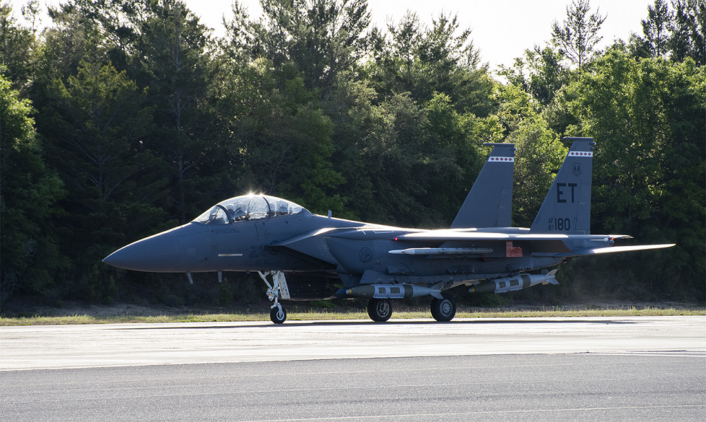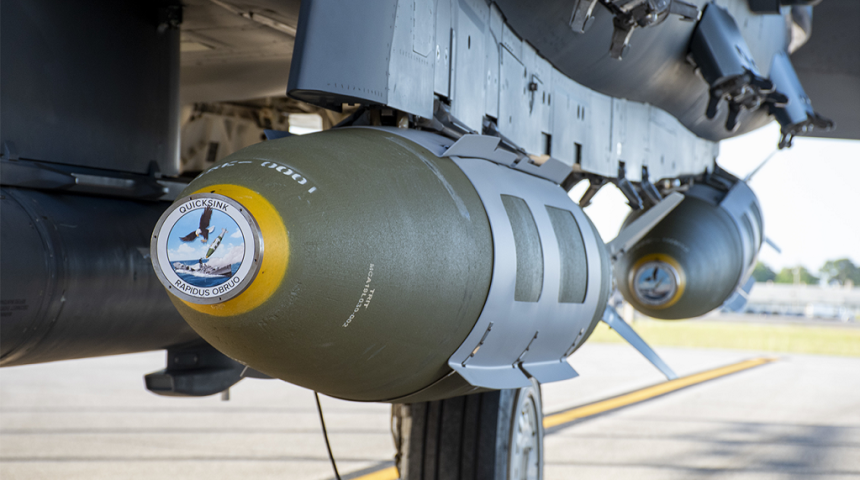The new variant, dubbed Quicksink, is intended to provide the Air Force with a torpedo-like anti-ship smart weapon.
The U.S. Air Force Research Laboratory (AFRL) and Eglin Air Force Base’s Integrated Test Team recently demonstrated a new low-cost, air-delivered smart weapon capability intended to defeat maritime threats. The test, which happened on April 28, 2022, saw an F-15E Strike Eagle releasing a modified 2,000-pound GBU-31 Joint Direct Attack Munition (JDAM) and successfully destroying a full-scale surface vessel in the Gulf of Mexico.
This test is the second experiment in the Quicksink Joint Capability Technology Demonstration, a collaborative effort with AFRL, the 780th Test Squadron of the 96th Test Wing, and the 85th Test and Evaluation Squadron of the 53rd Wing, and funded by the Office of the Under Secretary of Defense for Research and Engineering. “Quicksink is an answer to an urgent need to neutralize maritime threats to freedom around the world,” said Col. Tony Meeks, director of AFRL’s Munitions Directorate. “The men and women of this directorate consistently find ways to solve our nation’s greatest challenges.”
🚨QUICKSINK successfully destroyed a full-scale surface vessel in the Gulf of Mexico.🚨Learn more about this new low-cost, air-delivered capability for defeating maritime threats: https://t.co/nrC69bth5o#AccelerateChange #AFRL @DoDCTO @USNavy @TeamEglin pic.twitter.com/EKV6hlap96
— Air Force Research Lab – AFRL (@AFResearchLab) May 2, 2022
The Quicksink program, which is also being developed in a partnership with the U.S. Navy, aims to provide new options to rapidly neutralize stationary or moving surface maritime targets at minimal costs while also demonstrating the inherent flexibility of the joint force for future combat scenarios. “Quicksink is unique in that it can provide new capabilities to existing and future DOD weapons systems, giving combatant commanders and our national leaders new ways to defend against maritime threats,” said Kirk Herzog, AFRL program manager.
Usually, when dealing with enemy ships, the weapons of choice are submarine-launched heavy-weight torpedoes, which however pay their effectiveness with a high cost and a small portion of naval assets being able to employ them. “Heavy-weight torpedoes are effective [at sinking large ships] but are expensive and employed by a small portion of naval assets,” said Maj. Andrew Swanson, 85th TES division chief of Advanced Programs. “With Quicksink, we have demonstrated a low-cost and more agile solution that has the potential to be employed by the majority of Air Force combat aircraft, providing combatant commanders and warfighters with more options.”

Following the test, the AFRL released a video showing the moment the modified JDAM bomb impacted the target, an old cargo ship, which was split in half by the explosion and quickly sunk. The bomb appears to explode below the waterline, exactly as a torpedo would do. It is not known, however, what modifications were added to the GBU-31 to achieve this kind of effect.
As for the weapon guidance, this particular bomb combines its existing GPS-assisted inertial navigation system (INS) guidance package in the tail with a new seeker mounted on the nose, which however is not visible in the photos released. According to the press release, the AFRL is developing a Weapon Open Systems Architecture, or WOSA, seeker to enable precise placement of the weapon, lowering the costs while providing the ability to plug-and-play different manufacturers’ seeker components.









